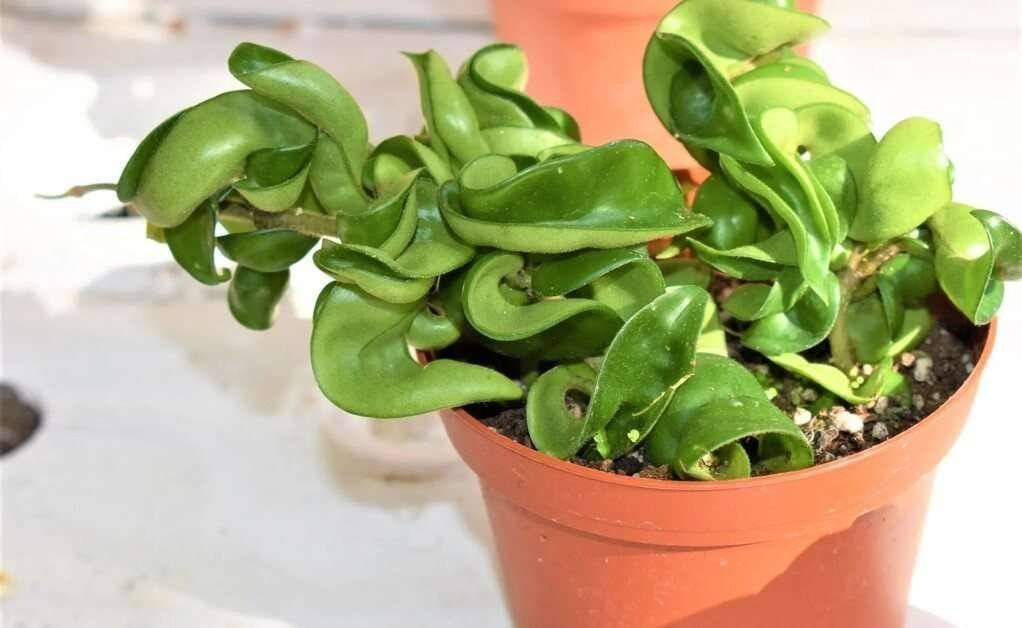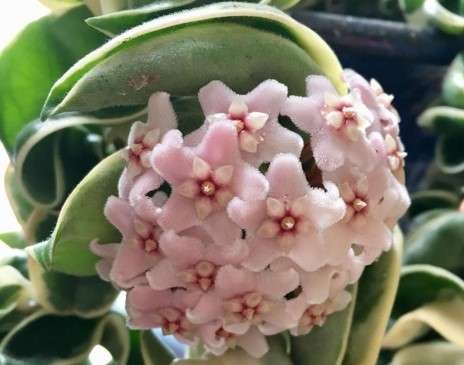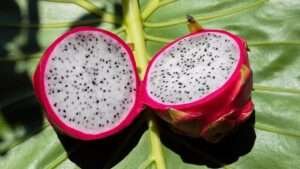This guide discusses how to care for the ” Hindu Rope Plant” and provides a complete guide.
What you will read in this Blog?
ToggleIntroduction to Hindu Rope Plant

The curly-leafed Hoya carnosa is a variation commonly known as Hindu rope. This semi-succulent, vine-like species is frequently kept as a low-maintenance houseplant because of its distinctive curled leaves, waxy foliage, and eye-catching blossoms. Higher humidity, well-draining soil, and bright, indirect light are all ideal conditions for Hindu rope growth.

Hindu Rope Maintenance

While it may grow slowly, Hindu rope is easy to care for, much like other Hoya species. The following are the primary maintenance needs for cultivating a Hindu rope plant:
- The plant should be placed in an area with bright, indirect light.
- Make use of perlite-containing light and a well-draining potting mix.
- Once the soil is dry, water deeply; during the winter, water less.
- Fertilize in the spring and summer every few months.
- If your plant proliferates, gently prune it in the spring to encourage bushier growth.
Light
Light: The ideal light for development and flowering is bright but indirect or filtered light, like light passing through a thin curtain, and it must be applied for at least six hours a day. Keep your Hindu rope plant away from windows exposed to the full afternoon sun. Excessive sun exposure can cause yellowing and burning of the leaves.
Soil:
Soil: To provide the best conditions for your Hindu rope plant, use a light-coloured, well-ventilated potting mix that drains quickly. This plant thrives in settings with light soil and minimal moisture. Incorporating perlite and orchid bark into the potting mix ensures optimal drainage and aeration, which are key to its health.
Water
The plant needs more frequent watering during its active growth season and more than usual in summer or the hot season. Please ensure the plant is growing in a pot with adequate drainage holes and give it plenty of water. The ideal way to water a plant is to hold it over the sink, wet the soil, let the water drain, and then set the pot back on a saucer.
Reduce the amount of watering during the winter and focus more on the plant’s humidity requirements.
Humidity and Temperature
Hindu rope requires temperatures continuously above fifty degrees Fahrenheit. Please keep it safe from abrupt temperature changes. Avoid placing your plant on a drafty windowsill or next to a radiator.
Low humidity may cause the leaf to lose its shiny, waxy appearance. Dry air is particularly problematic when heating your home in the winter. To raise the humidity, use a humidifier or set the plant pot on a pebbled tray. The Hindu Rope Plant raises the moisture as the drained water evaporates and stays beneath the plant without contacting the roots.
Apply fertilizer
For maximum flowering, feed the plant a small amount of high-potassium fertilizer every few months during the spring and summer. Throughout the winter, the plant won’t require any nourishment.
Hindu Rope Plant Types
While there are numerous H. carnosa cultivars and variants, only a few known varieties of Hindu rope, or H. compacta, Hindu rope’s popularity has recently led to a few variegated varieties among houseplant fans, and more may follow shortly.
- Though its leaves are curled, H. compacta ‘Regalis’ resembles H. carnosa ‘Krimson Queen’ in that it has white variegation on the margins of its leaves.
- With its curled leaves, H. compacta ‘Mauna Loa’ resembles H. carnosa ‘Krimson Princess’ in its inner, cream-coloured variegation.
- Lighter-colored leaves and the well-known “splash” pattern seen on other Hoya species, such as H. publicly ‘Splash,’ characterize H. compacta ‘Jodie’s Silver.’
Trimming the Hindu Rope Plant
Cut back dead growth and trim back lanky stems in the spring, around once a year. But be careful not to cut off the plant’s peduncles, as this would prevent flowers from blooming the following season.
Propagate the Hindu Rope Plant.
- If you want to grow a Hindu rope plant fast, then use its cutting to propagate it.
- Take a good stem and cut off a 4-inch section. At the very least, the cutting should have two or three nodes. Remove the leaves from the bottom part.
- Let the cutting air dry for a whole night.
- Keep the cutting moist and place it in airy, well-drained potting soil. Alternatively, submerge it in water (if you have a propagation vase, use it). Like mature plants, cuttings take a while to root and flourish, so be ready to wait.
Hindu Rope Plant: Planting and Reporting
These plants do not require frequent repotting because they are slow-growing and prefer to be root-bound. Generally speaking, it is advised to plant them in a tiny container so that they will increase. Due to the lower size, overwatering will be less likely. Just make sure that the pot you choose has many holes for drainage.
It is crucial to monitor your Hindu rope plant regularly. If you notice thin roots blocking the pot drainage holes, over-compaction of the potting mix, or the soil drying out rapidly after watering, these are clear signs that your plant needs to be repotted.
Typical Pests
Pests are unlikely to be drawn to these resilient plants. However, a stressed Hindu rope plant may become host to aphids, scale, or mealybugs, especially if humidity levels are not maintained sufficiently. Horticultural oil, high humidity, and regular care can all be beneficial.
How to Get Hindu Rope to Bloom
Growing Hindu rope can be unpredictable and difficult at first. All you can do is take the best possible care of it indoors, careful not to damage the peduncles from which the flowers arise.
Months of Bloom
Hindu rope typically begins to bloom in the spring, summer, or fall, generally in March. However, keeping the plant indoors frequently results in unexpected blooming dates. Hindu rope has the potential to bloom continuously for the entire year.
How Long Does Hindu Rope Bloom?
Though the plant can continue to bloom much longer, Hindu rope blooms often endure for many weeks.
What Do Hindu Rope Flowers Look and Smell Like?
The small, star-shaped, pinkish-white blooms are grouped in balls. They have a slight chocolate scent.
Ways to Promote More Blooms
Be patient when dealing with a new plant, as it can take several years to bloom. If you still need to see it blossom after several seasons, ensure it receives enough light, isn’t kept dry for extended periods, and isn’t overfertilized. Both too much fertilizer and too little water can cause a plant to produce few or no blooms. Excessive watering or droughting can also cause buds or flowers to droop.
Common Problems with Hindu Rope
Wet circumstances are a significant issue for this species since they cause blossom drop and root rot. This plant must be watered carefully. Other than that, Hindu rope is not affected by numerous typical issues.
Yellow Leaves
Leaves frequently turn yellow as they wither and perish. This mild yellowing is normal as long as it is limited to a few leaves here and there and not the entire plant or vast areas of it. Fungal infections are typically the cause of massive yellowing. To help prevent this, avoid overwatering the plant.
Wilting Plant
Even though these plants adore being confined to their roots, if yours starts to wither, it may be too big for its pot. Transfer it to a fresh container that is marginally larger than the last one.
Ensuring a Long Life for Your Hindu Rope Plant
Take into account these maintenance suggestions to make sure your Hindu rope plant reaches its maximum potential:
- As the vines enlarge, make sure they have enough support. Heavy vines might break if not held up correctly.
- Cut the plant back a bit. Pruning a plant too much might cause stress and weaken it.
- To reduce stress, let your plant establish itself well in its new spot without moving about too much.
- When using chemical treatments, exercise caution and, if possible, use gentle, natural pest control techniques.
FAQs about Hindu Rope Plant
Is Hindu Rope Plant Toxic to Pet Animals?
Pet owners should be aware that the Hindu rope plant, despite its beautiful appearance, is poisonous to cats and dogs if consumed. Compounds in the plant can make pets drool, throw up, and have diarrhea. The sap irritates animals’ mouths and gastrointestinal tracts, causing these reactions.
For this reason, if you live in a home with curious animals, you must keep the Hindu rope plant out of the reach of your pets or reevaluate its placement. You should immediately contact a veterinarian if your pet has eaten any plants.
How Fast Does Hindu Rope Plant Grow?
The sluggish growth rate of the Hindu rope plant is a characteristic shared by most Hoya types. During the growing season, under ideal circumstances, you may witness the progressive emergence of new leaves and vine expansions. These plants frequently take several years to attain their maximum size and begin to bloom.
When taking care of a Hindu rope plant, patience is essential. Consistent maintenance per the previously mentioned conditions can promote continuous development but slowly compared to other houseplants. Part of what makes the Hindu rope plant a low-maintenance choice for indoor gardeners is its slow growth rate.
Why is My Hindu Rope Plant Dying?
Underwatering or Overwatering: Inappropriate watering is the most frequent error that causes Hindu rope plants to develop slowly. Because they are succulent, these plants can withstand some drought, but prolonged dryness might stunt their growth. On the other hand, overwatering can result in root rot, significantly impairing the plant’s capacity to take in water and nutrients and slowing down its growth. In between waterings, please ensure the soil around the plant is dry, but don’t let it dry out so much that it becomes unhealthy.
Why is it called the Hindu Rope Plant?
It’s important to note that the moniker “Hindu Rope Plant” describes this hoya species’ distinct appearance. As it grows, its thick, green leaves twist and turn, creating something resembling the coiled ropes utilized in Hindu rituals and rites. The plant’s alluring appearance and low maintenance requirements have made it a popular option for those who enjoy houseplants for their aesthetic value and symbolic meaning.
Is the Hindu Rope Plant Indoor or Outdoor?
The Hindu rope plant is primarily an indoor plant that grows best in a regulated space like a house or office, where its particular humidity, light, and temperature requirements may be more easily satisfied.
It can be left outside under specific circumstances, such as in a sheltered, shaded location in climates similar to its natural tropical habitat. However, intense heat or direct sunlight can damage the plant, so caution must be exercised when placing it outside. Because of their distinctive look and low upkeep needs, indoor plants can bring a little of nature’s artistic flair into your living area.
What is the Scientific Name of the Hindu Rope Plant?
The Hindu rope plant is known by its scientific name, Hoya carnosa ‘Compacta.’ Its name sets it apart from other members of the Hoya genus, and it is well-known for its eye-catching and exquisite flowering plants.
Where do you cut a Hindu Rope for Propagation?
- Cuttings should be made just below a node or the place on the stem where leaves appear to propagate a Hindu rope plant.
- Use a sharp knife for cutting.
- A standard cutting should have at least one node and be a few inches long; this is where the new roots will grow.
- After cutting, let the cutting harden off for a day before planting it in a potting mix that drains properly.
- A young Hindu rope plant will root and grow more readily if the soil is kept slightly moist and bright; indirect light is provided.
How do you Root a Hindu Rope Plant?
Using the proper strategy, rooting a Hindu rope plant (Hoya carnosa ‘Compacta’) might be simple. The following procedures will help you effectively root a cutting of your Hindu rope plant:
Choose a Healthy Cutting:
Selecting a solid stem with two or three nodes—the points where leaves are attached—is crucial. As each node has the potential to develop roots, a more extended cutting with more nodes could enhance your chances of success.
Prepare the cutting:
Cut immediately below a node with a knife or a sharp pair of scissors. Since the new roots will grow from the nodes, remove the lowest leaves around the cut to reveal them.
Rooting Medium:
You can root your cutting straight in the soil or in water. To initiate water roots:
- Immerse the cutting in a small water-filled container, ensuring that at least one node remains submerged.
- Change the water every few days to keep it fresh.
- Use well-drained soil for planting the cutting.
Setting:
Creating the right environment is critical. Keep the cutting away from direct sunlight in a warm, well-lit spot. Ample humidity is beneficial for rooting, so cover the pot with a plastic sheet to maintain moisture.
Patience and Care: It may take weeks to months to root fully. Ensure the medium (soil or water) is damp but not drenched. Don’t overwater when rooted in soil to prevent rot. When leaves are spread out, it is considered a successful growing plant.







